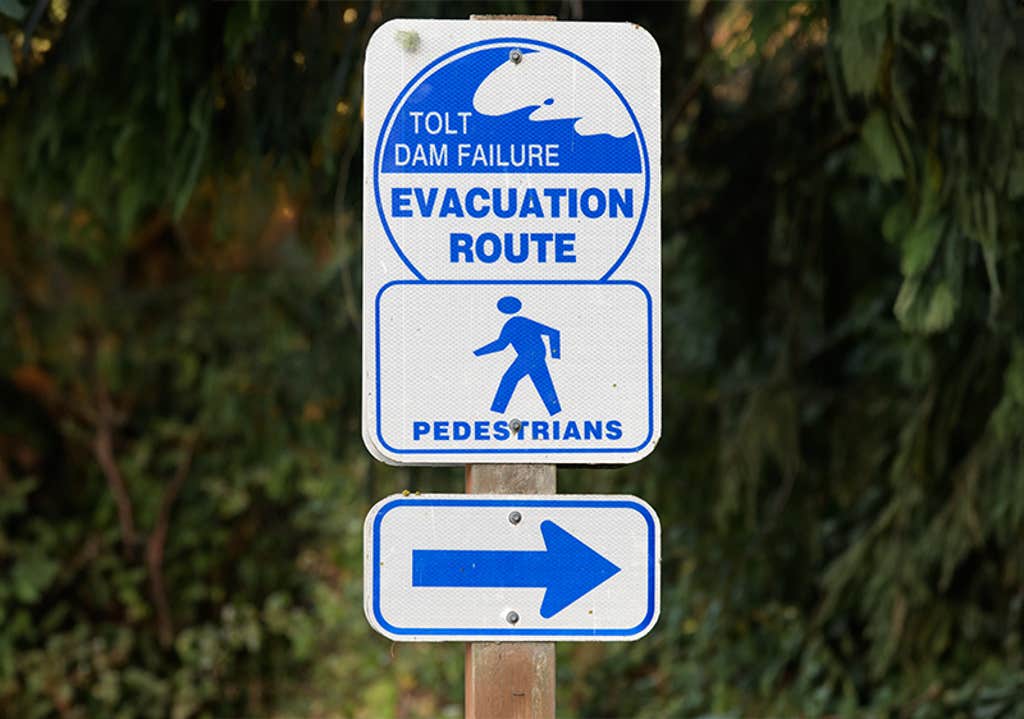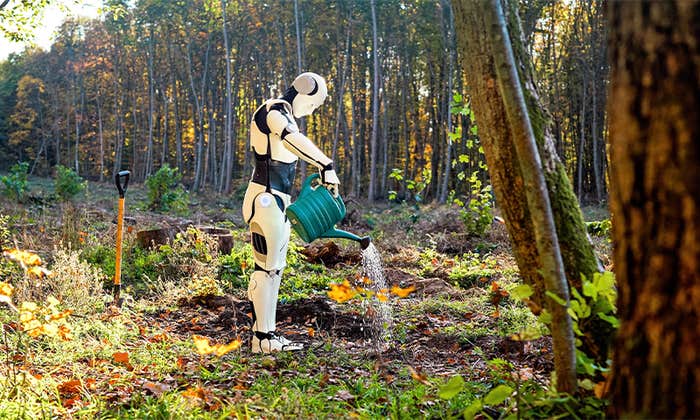In rural Washington, on a dry July morning in 2020, Collienne Becker stood at the edge of her driveway and prepared to face a wall of water.
Minutes earlier, she’d stepped onto the porch of her farmhouse to smoke a cigarette when she heard a familiar, jolting sound. Every Wednesday at noon for as long as anyone in the town of Carnation could remember, a high-pitched siren had blared in the small city, followed by a weekly dose of reassurance over a loudspeaker: “This is a test of the Tolt Dam Warning System.”
For decades, the City of Seattle has owned and operated, from afar, the Tolt Reservoir and Dams, which supplies about a third of greater Seattle’s drinking water. Carnation—a small farming community of just over 2,000 people in the Snoqualmie Valley, about 30 miles east of the city—receives none of that water, but bears all of the risk of the operation. In the improbable event that the 200-foot-high dam fails, a 30-foot wave of water could surge down the South Fork Tolt River and inundate this small town.
“I’m going to die,” she thought.
Since the time they’re children, locals learn that an alarm on Wednesday at noon is nothing to worry about: It’s just routine testing—everything is fine. But if the siren sounds at any other time during the week, it’s reason to head for higher ground immediately.
This time, it was a Tuesday. A message over the alarm’s accompanying speaker confirmed everyone’s fears: “The Tolt Dam has failed. Evacuate the area immediately.”
Becker, who had recently retired from Amazon, and her husband, Michael, scrambled to grab food and water and leashes for their howling golden retrievers. Yet, by the time they corralled the animals into their Toyota 4Runner, the typically vacant road abutting their property was already bumper-to-bumper. Roaring fire trucks had alerted families to scoop up their kids. They had an hour, tops, to leave town or climb to a higher elevation.
With most of the traffic heading west, away from the reported deluge, Becker decided, somewhat counterintuitively, to drive east toward the dam. The couple had friends who lived in the thickly forested highlands nearby. They could hole up there, potentially. But she only made it a mile. A woman driving a horse trailer had jackknifed across the narrow country road and gotten stuck, blocking it for everyone, after a passerby said a bridge nearby had breached and she needed to turn around.
So Becker doubled back, illegally driving westbound in the empty eastbound lane, incredulous that people were still waiting for the traffic light in the other lane when they could potentially drown at any moment. When she reached home, she walked down her driveway, and, with traffic westbound out of town at a standstill, decided to await her fate. She imagined their farmhouse, one of the oldest structures in the area, getting swept away. She imagined worse. I’m going to die, she thought.
“That’s when a guy said, ‘Oh, it’s all false. Don’t worry about it,’” says Becker. As she stood immobilized in her driveway, he leaned from his car and told her he’d seen a Facebook post that suggested the siren was a false alarm. Becker wasn’t sure whether to trust him, but a sheriff soon came by and confirmed the rumor. A crew working on the warning system had accidentally set it off. Everyone could go home.
The siren, which blared for more than 40 minutes, was the first and most harrowing of eight false alarms that sounded over a four-year span in Carnation. These repeated false alarms left residents with lingering stress, anxiety, and jangled nerves.

In August 2023, after the sixth failure of the alarm, the city declared a state of emergency, imploring Seattle officials to fix the problem. “Seattle’s dam puts all of our lives and property at risk,” Jim Ribail, Carnation’s mayor, told Seattle City Council that September. But even as Seattle Public Utilities has worked to improve the faulty warning system with new technology and equipment, they can’t alleviate the psychological toll it has already taken. “There are many people that live here today that still suffer from the PTSD [of] this first event,” Ribail said during a community forum later that month.
In the aftermath, some locals have taken measures to protect their mental health. One resident on the autism spectrum sets a timer for two minutes before the test siren on Wednesdays to mitigate his agitation. Becker, meanwhile, leaves town entirely on Wednesdays—every Wednesday. Once a standard, if still jarring, interjection in the quiet rhythm of the town, the siren is now “a trigger,” she says—an anxiety-inducing reminder of that awful day.
Beyond the haunting psychological effects, however, a more insidious and potentially damaging response to the spate of false alarms has also set in across Carnation: There have been so many false alarms, Becker says, that she and others are experiencing “the ‘cry wolf’ thing.” She says, “If it had went off today, I would have probably had that rush of panic, but I would have waited to try to figure out whether it was real or not. Waiting is probably not the right decision, but I just don’t trust it anymore.”
She’s not the only one. Each time the alarm sounded in Carnation, Ribail hopped in his truck and drove up to a 20-acre evacuation site in the Tolt Highlands. Each time, the mayor has waited for his constituents to join him there, only to discover “nobody’s coming up,” he says.
As extreme weather events become more commonplace, cities around the globe are working to set up more early warning systems. Reported weather related-disasters increased almost fivefold from 1970 to 2019, while economic losses related to those disasters rose nearly sevenfold, according to a recent World Meteorological Organization report.
But over that same timespan, deaths from weather disaster-related disasters dropped by a factor of three. The WMO attributes the higher survival rates to improved disaster management and more early warning systems—in areas with fewer reliable forecasts and warnings, the rates of fatalities are higher. In 2022, the United Nations launched an “Early Warnings for All” initiative to “ensure that early warning systems protect everyone on Earth by 2027.”
Subscribers received three alerts that killer doll Chucky was on the loose.
But not all warning systems are created equally. Natural disaster alerting systems are generally more accurate than they once were but remain fallible, so those designing new systems have to ask themselves: What are the consequences of too many alarms versus too few? How frequently and under what circumstances should an alarm go off? And how can we protect these systems from embarrassing hacks, such as the one that occurred in Texas in 2021, in which subscribers received three alerts that killer doll Chucky was on the loose?
In our era of climate change, “having warnings that actually make people evacuate becomes more and more important,” says Katharina Hembach-Stunden, a researcher who worked on a recent study of the cry wolf effect while at Osnabrück University in Germany.1 “If you have too many false alarms, there’s a lot of research that hints toward people becoming more reluctant to actually respond to it. So you’ve run this risk of them not evacuating and then having higher losses—deaths.” Changing behavior is difficult, she says.
As long as the ancient story of the boy who cried wolf has circulated, common sense has dictated that the public won’t believe a liar—even when he or she is telling the truth. One of Aesop’s most famous fables centers on human morality, but it has long guided the popular understanding of how people interpret false alarms from insentient sources, too.
The story’s lesson was committed to the annals of psychological research in the 1980s when Holocaust survivor and University of Haifa professor Shlomo Breznitz applied his expertise on stress to false alarm responses. Warning systems had become increasingly prevalent in fields such as meteorology and defense, he observed in his 1984 book, Cry Wolf: The Psychology of False Alarms. But these detectors still leaned on an external variable—their credibility—to achieve their intended effect. Through laboratory experiments that involved threatening, and then canceling, painful shocks, Breznitz found that every false alarm reduced the perceived trustworthiness of alert systems.
The book has served as a foundational text for contemporary research on what’s now known as the “cry wolf effect,” which contends that a warning system’s credibility loss from a false alarm leads to complacency. In the face of emergencies, this effect manifests in a lack of protective action, such as sheltering in place or evacuating.
Some scholars have found evidence of the cry wolf effect in medical monitoring and natural disaster responses. Repeated false alarms in intensive care units can lead to alarm fatigue among nurses, which can compromise patient care and raise the risk of accidents and death. And a high regional rate of false alarms from the National Weather Service has been linked to increases in natural disaster injuries and fatalities.2
But it seems humans don’t always behave as the folklore suggests. “Despite expectations to the contrary, much of the hazards literature suggests no cry wolf effect or negative influence of false alarm on household perceptions and behavior,” wrote disaster and weather scientists in a 2015 issue of Weather, Climate, and Society. This was true, they found in their literature review, for hurricanes, tornadoes, and floods.

In 2019, a National Oceanic and Atmospheric Administration study further complicated the conventional wisdom.3 NOAA wanted to examine false alarms for tornados because of the potentially deadly consequences and high frequency of these natural disasters; about three-quarters of National Weather Service tornado warnings end up being false alarms, the greatest ratio for any natural disaster.
Surveys of more than 4,000 southeastern United States residents discovered that people are very bad at estimating how often an alarm is false and that, even in areas with high numbers of false alarms, residents still sought shelter at among the highest rates.
“There’s mixed findings in that research, which is what makes it so interesting,” says Sarah DeYoung, a professor in the University of Delaware’s Disaster Research Center who was not part of the NOAA study. “In some communities, it’s led to hyper vigilance. In some communities or instances in some studies, it’s led to reduced vigilance.”
The different types of hazards and communities in these studies likely helps to explain the disparate results, according to DeYoung. For instance, how one might respond to an alarm for a tornado in a region accustomed to them may not be a good analogue for, say, how one would respond to an alarm warning of an unprecedented dam breach, says JungKyu Rhys Lim, who contributed to the NOAA study while he was a researcher at the University of Maryland.
But Lim says a far more unusual false alarm that happened in Hawaii recently reminds him of Carnation’s plight.
Since 2012, various U.S. government authorities have sent tens of thousands of text message-like Wireless Emergency Alerts to inform different areas of crises such as missing children and severe weather. But at 8:08 a.m. on Jan. 13, 2018, residents of Hawaii received one unlike any before or since: “BALLISTIC MISSILE THREAT INBOUND TO HAWAII. SEEK IMMEDIATE SHELTER. THIS IS NOT A DRILL.”
It would be another 38 minutes before the government sent another alert with the professional equivalent of “just kidding.” Like in Carnation, a local agency was responsible for accidentally activating a false alarm.
Before the follow-up message, confusion reigned on the state’s constellation of islands. Locals wondered whether they were about to endure another Pearl Harbor. Some assumed it had been sent in error. Others called loved ones, thinking they were about to die, and desperately sought more information. A few were more fatalistic, wandering to the beach to drink wine.
These responses, and the aftermath show the wide variety of ways humans may react to the same incident. In a follow-up study in International Journal of Disaster Risk Reduction, for example, at least one survey respondent reported he could never trust the Hawaii Emergency Management Agency again, while others said they’d be more prepared to take precautions for the next missile alert.4
This dichotomy persists in Carnation, too. Kira Avery, the executive director of the Sno-Valley Senior Center, says the organization has a greater understanding of evacuation protocols now to protect some of the area’s most vulnerable residents. “It has definitely prepared us more,” she says.
When the first false alarm siren went off in Carnation in July 2020, Avery remembers looking behind the senior center at the city offices. She saw workers there getting in cars to evacuate. “It was then when we realized, ‘Okay, this is not a test. We need to leave.’” Similarly, the town’s mayor, Ribail, who was in nearby Redmond at the time, dialed Carnation’s treasurer to confirm the danger. “This is real,” she told him.
Some called loved ones, thinking they were about to die. A few wandered to the beach to drink wine.
Sharing information with others nearby to better understand a threat and its potential implications—also known as “milling”—was a common reaction in Hawaii, too, the survey found. Neighbors there conferred in driveways and messaged online, suggesting that before people decide to react to an alarm, they may consult others in the community rather than just rely on independent judgment. “I’ve noticed, across all my research and in my personal life, people do that social milling thing, where they’re going to look to see what other people are doing,” says DeYoung, who was one of the authors of the Hawaii paper.
Those who went online usually found reassurance sooner. Some saw posts by Hawaii congresswoman Tulsi Gabbard that dispelled the missile myth. But others bemoaned the lack of physical cues around them. “A lot of people talked about listening for or noticing a lack of air raid sirens,” says Jennifer Trivedi, an assistant professor in the University of Delaware’s Disaster Research Center who conducted interviews on the ground after the false missile alert.
A similar complaint would resurface five years later, after the Maui wildfires. The island has 80 siren towers—when natural disaster is imminent, they’re designed to blast long tones to let the public know to seek more information on radio or television and to evacuate to higher ground, head inland, or if they are inside a concrete building, to climb to the fourth floor or higher. The sirens are tested routinely, each month. But during the blazes, officials decided not to activate them at all—in part, for fear that residents would head into the hills, putting them at greater risk. Instead, they sent out only phone notifications. But many people never received these digital alerts, inviting a different but nagging question: How can we manage—and measure the efficacy of—alarms in an era of increased natural disasters if some people never hear the cry?
The roots of that question date back to the 1960s. At the time, scholars David Green and John Swets had just formulated what is known as signal detection theory, which proposed a framework for how people respond to stimuli, or signals—such as disasters—in situations of uncertainty. If they perceive a signal—say, a flood—but don’t get an alarm, it’s a “miss.” If they get an alarm, but no flood occurs, it’s a false alarm. Neither is a desired outcome, but which is worse over the long run?
In a study published in Q Open: A Journal of Agricultural, Climate, Environmental, Food, Resource, and Rural Development Economics, researchers examined how individuals would respond to an alarm system that frequently missed events—giving a “safe” forecast ahead of a dangerous storm—versus one that frequently issued false alarms related to seasonal forecasts. In an online experiment that sought to test this idea through simulated scenarios, subjects received probabilities for normal and extreme seasons and were allocated “points” to pay for protection. Over a series of 10 seasonal projections and prompts, researchers found that false alarm-prone forecasts led to less investment in adaptation than more accurate ones—the cry wolf effect, in other words.
But with alarm systems prone to miss weather events, they observed more investment in adaptation, regardless of whether a warning was issued. Essentially, participants stopped trusting the safe forecasts.
When designing a forecast and a warning system, engineers and policymakers have to find the right balance between false alarms and missed alarms, says Hembach-Stunden, the lead author of the study, because both come with some long-term costs. “Finding the right balance is very dependent on what is at risk,” she says. “So I see a big challenge there for people who are making the decisions on how these forecasts or warning systems should be designed.”
Jeannette Sutton, an associate professor at SUNY Albany who studies disaster warnings, says relying on just one warning system can be dangerous. Started in 2012, Wireless Emergency Alerts, for example, were sent to phones more than 84,000 times in their first decade of existence. But emergency managers for different parts of the U.S. have different policies and thresholds for delivering these text-like warnings, Sutton says. Bombarded users can opt out of them entirely; too many missing person alerts, say, could lead to someone to turn the alerts off or tune out—and then miss one for a deadly tornado. “I don’t think that we think broadly enough about how our actions in one place are going to affect another place,” says Sutton.
Early last fall, Carnation finally received some good news about its own siren problem. Seattle would be replacing the outdated Tolt Dam Early Warning System with a new one that October. “We value protecting life through our services that we provide, and clearly we have failed in doing that for all of you,” Seattle Public Utilities general manager and CEO Andrew Lee told the crowd at the community forum in late September.
But no sooner had SPU installed a new system than it had introduced a new problem: The alarm wasn’t loud enough. Local officials and neighbors swiftly gathered for a press conference along a trail where a new siren, shaped a bit like a honey dipper, rose between evergreens. “Even for me, living right across the street from it, it’s far more difficult to hear and understand compared to the previous one,” one resident said. Another local added that they had to pause conversation in downtown buildings to make out the alarm.
Since the initial rollout, SPU has upgraded its sirens. It’s also slated to add more indoor alerting devices, evacuation signs, and highway messages this year. But in late March, the alarm went off again, the eighth false alarm in four years.
These false alarms continue to take a serious psychological toll.
When SPU announced it would test the new system in Carnation this coming fall over multiple days, it was easy for Becker to schedule a trip to Nevada. “I couldn’t stand hearing it,” she says, “because it sends me back to that day every time.” When the dam’s warning system went off that first time in July, her father had recently died. She called her mother for what she thought would be the last time.
Becker has considered moving but stresses that she’s a “strong-willed person.” About two decades earlier, when she was working in one of Amazon’s corporate high-rises downtown, she felt the Nisqually earthquake rattle the building. “I don’t let that kind of thing bother me. I just don’t,” she says. But her experience with the Tolt Dam false alarm, she says, hit her differently. “I can’t shake it. And I don’t know why.” ![]()
Lead image: Roman Samborskyi / Shutterstock
References
1. Hembach-Stunden, K., Vorlaufer, T., & Engel, S. False and missed alarms in seasonal forecasts affect individual adaptation choices. Q Open 4, qoad031 (2023).
2. Simmons, K,M. & Sutter, D. False alarms, tornado warnings, and tornado casualties. Weather, Climate, and Society 1, 38-51 (2009).
3. Lim, J.-K.R., Liu, B.F., & Egnoto, M. Cry wolf effect? Evaluating the impact of false alarms on public responses to tornado alerts in the southeastern United States. Weather Climate and Society 11, 549–563 (2019).
4. DeYoung, S.E., Sutton, J.N., Farmer, A.K., Neal, D., & Nichols, K.A. “Death was not in the agenda for the day”: Emotions, behavioral reactions, and perceptions in response to the 2018 Hawaii Wireless Emergency Alert. International Journal of Disaster Risk Reduction 36, 101078 (2019).




























